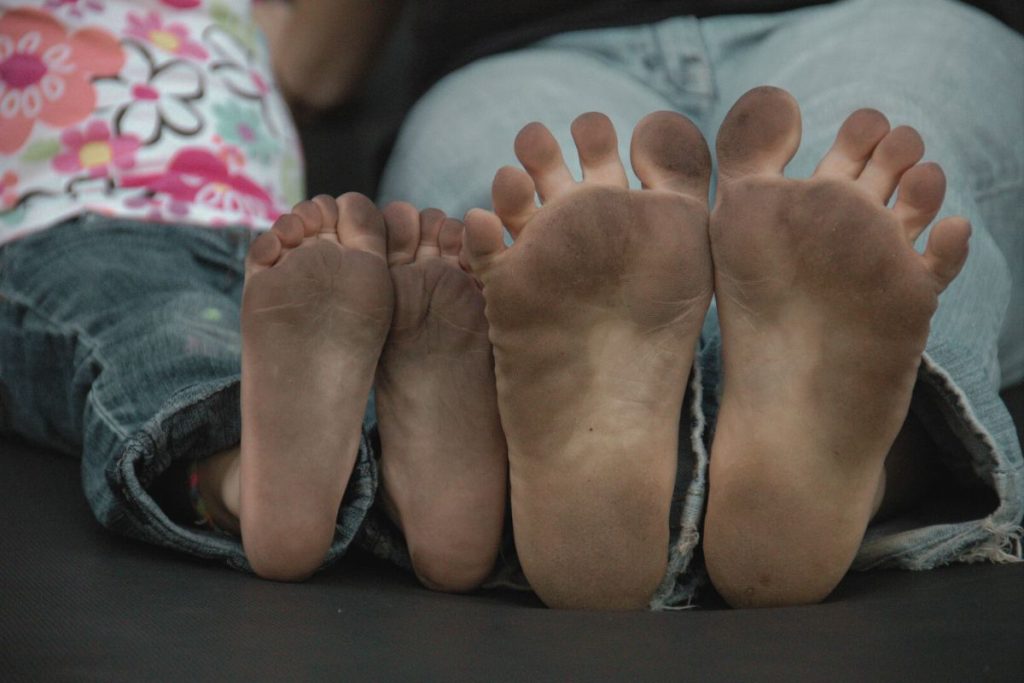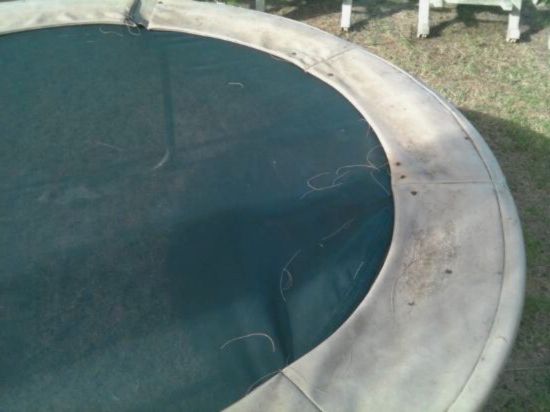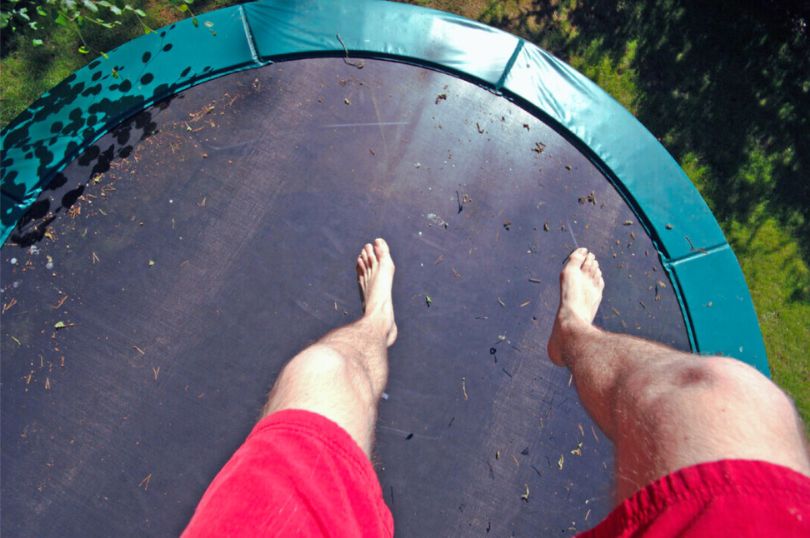Have you ever noticed that after bouncing around on your trampoline, your feet are mysteriously blackened? It’s a common conundrum for trampoline enthusiasts and puzzled parents alike. This peculiar phenomenon raises questions about the cleanliness and safety of trampolines, prompting curiosity about the reasons behind it.
While trampolines offer exhilarating fun and fitness benefits, the issue of blackened feet adds a layer of concern. Understanding the causes behind this occurrence involves exploring factors like outdoor exposure, material composition, and environmental elements.
By unraveling the mystery of why trampolines leave us black-footed, we can take proactive steps to mitigate potential health risks and ensure a cleaner, safer bouncing experience for all.
Let’s delve into the science behind this curious quirk and uncover solutions for keeping our trampoline adventures free from unwanted foot discoloration.
What is “Black Foot” and Why Does it Happen?
“Black foot” refers to black marks left on the soles of feet after using a trampoline. This typically occurs when the skin on the feet has prolonged contact with certain chemicals used in trampoline mat production. Additionally, sweat, dirt, and other materials stuck to feet can transfer to the mat and undergo chemical reactions. The result – those unsettling black stains on your feet.

Material Composition of Trampoline Mats
The type of material used to construct trampoline mats plays a significant role in black foot. Traditional woven polypropylene mats contain plasticizers to increase durability. Newer springless “Permatron” style mats also utilize UV stabilizers and other chemicals to improve longevity. While useful during manufacturing, residual chemicals can transfer to skin, especially when magnified by heat and friction.
Environmental Factors
Outdoor trampolines experience much harsher conditions compared to indoor setups. Prolonged sunlight exposure degrades mat materials faster while rain introduces more dirt and accelerates wear. As protective topcoats in outdoor mats erode over time, the risk of chemical leaching to the skin increases. Indoor trampolines, by contrast, last longer thanks to protection from the elements.

Human Factors
Even with pristine mats, black foot can still occur due to substances on fee themselves. Sweat and skin oils provide a conduit for chemical transfer to the skin. Likewise, any dirt, grass, or debris stuck to feet can grind into the mat, forming abrasive carbon deposits resembling black foot stains. Proper hygiene and regularly cleaning feet before use reduce this risk. But frequent high-intensity exercise accelerates mat wear regardless, necessitating replacement every few years.
A few Common Reasons for Black Foot
Jumping on a trampoline is a fun activity, but it can sometimes lead to the development of black foot, also known as trampoline foot. This condition occurs due to a few different reasons.
- Grim and dirt: When jumping on a trampoline, especially outdoors, grim and dirt can accumulate on the surface. These particles can stick to the feet and cause discoloration, leading to black foot.
- Mat’s carbon: Trampoline mats are often made with carbon black as a component, which helps with UV resistance and durability. However, this carbon black can rub off onto the feet during jumping sessions, resulting in black foot.
- Sun UV rays: Exposure to sunlight can cause the trampoline mat to degrade over time, leading to the release of black particles. Jumping on a worn-out mat exposed to UV rays can result in black foot due to the transfer of these particles onto the feet.
- Getting old: As trampolines age, their mats can wear down and become more prone to shedding black particles. Additionally, the springs and other components can deteriorate, leading to increased friction and abrasion, which can contribute to black foot.

Health Concerns Related to Black Foot
Exposure to the chemicals that cause black foot can lead to additional skin health issues. The irritating black residue is problematic itself as it sticks persistently to feet. More significantly, ingredients from low-quality mats could trigger allergic reactions, rashes, or inflammation.
Skin irritation and allergic reactions
Cheap trampoline mats may utilize industrial chemicals and fillers that leach out over time. Prolonged skin contact can cause redness, itching, swelling, or hives. Those with sensitivities or allergies face a higher risk for adverse reactions.
Risks of bacterial or fungal infections
The moist, abrasive conditions inside trampoline mats provide ideal environments for microbes to breed. Germs and fungi which thrive in these warm habitats can transfer to feet via black foot residues. This may lead to bacterial or fungal infections.
Importance of proper foot care and hygiene
Practicing consistent foot hygiene minimizes health risks associated with black foot. Thoroughly cleaning feet before and after trampoline use safeguards against infection while removing irritating chemicals. Appropriate aftercare also lowers risks following exposure.
Mitigation Strategies
Several straightforward measures assist in preventing black foot. With minor habit adjustments, you can circumvent chemical transfer while prolonging mat longevity.
Regular cleaning and maintenance of trampoline
Over time, dirt, debris, weather, and heavy use degrade trampoline parts. Following the manufacturer’s care guidelines maintains protective topcoats longer. Vacuuming mats routinely also limits abrasive buildup.
Use of protective footwear while jumping
Barrier fabrics like socks mitigate direct skin contact with chemicals in mats. Breathable athletic shoes also shield feet from fungi and bacteria dwelling within worn padding. For casual backyard bouncing, sandals are preferable over bare feet as well.
Application of protective coatings or sprays
Seeking out mats made with non-toxic, stabilized materials lowers irritation risks overall. Alternatively, spray-on shields fortify mat surfaces against UV rays, sweat corrosion and everyday wear. DIY applications generally require re-coating every six months.
Awareness of personal hygiene practices
Black foot typically appears after intense workouts which induce heavy sweating. Over time, perspiration residues can “rot” the padding. Showering before sessions prevents odor and bacteria transferal to mats. Carrying hygiene wipes while jumping facilitates quick midday cleanups too.
Consideration of alternative trampoline materials
If despite best efforts black foot persists, replacing worn pads may be warranted. Permatron mats forgo chemicals associated with skin irritation. Marine-grade canvas bed trampolines also withstand outdoor elements longer before fraying.
Remove Cloth Stains from Trampoline
Removing stains from clothes after bouncing on a trampoline can be a tricky task, but with the right approach, you can regain the pristine look of your garments. Here are some practical tips to tackle those stubborn stains:
Act Quickly: The key to successful stain removal is prompt action. As soon as you notice the black stains on your clothes, don’t procrastinate. Head straight to the laundry room and grab the necessary supplies.
Blot, Don’t Rub: Blotting is more effective than rubbing when dealing with stains. Gently blot the stained area with a clean cloth or paper towel to absorb as much of the black substance as possible without spreading it further.
Pre-treat the Stain: Apply a stain remover or a mixture of liquid laundry detergent and water directly onto the black stain. Allow it to penetrate the fabric for a few minutes to break down the stain before washing.
Check Fabric Care Labels: Before proceeding, always check the care labels on your clothes. Different fabrics require different treatments, and following these guidelines will help you avoid damaging the garment during the stain-removal process.
Wash in Cold Water: When it comes to washing stained clothes, opt for cold water. Hot water can set the stain, making it more challenging to remove. Use a good-quality laundry detergent to ensure effective cleaning.
Use Oxygen Bleach: For whites and colorfast fabrics, consider using oxygen bleach. It is gentler than chlorine bleach and can help lift stubborn stains without causing discoloration. Follow the instructions on the bleach packaging for proper usage.
Repeat if Necessary: Some stains may require more than one treatment. If the stain persists after the first wash, repeat the pre-treatment and washing process until you achieve the desired result.
Air Dry to Check: After washing, air-dry the garment to assess the effectiveness of the stain removal. Avoid using the dryer until you are certain that the stain is completely gone. The heat from the dryer can set any remaining residue.
Conclusion
The phenomenon of trampolines leaving individuals with blackened feet underscores the importance of proper maintenance and caution. While trampolines offer recreational enjoyment, neglecting routine cleaning can result in accumulation of dirt and debris, leading to this issue. Regular inspection and cleaning of trampoline surfaces can mitigate the risk of such occurrences.
Furthermore, wearing appropriate footwear while using trampolines can provide an extra layer of protection. Ultimately, by prioritizing cleanliness and safety measures, individuals can continue to enjoy the benefits of trampolining without the inconvenience of blackened feet.
Last Updated on February 16, 2024

